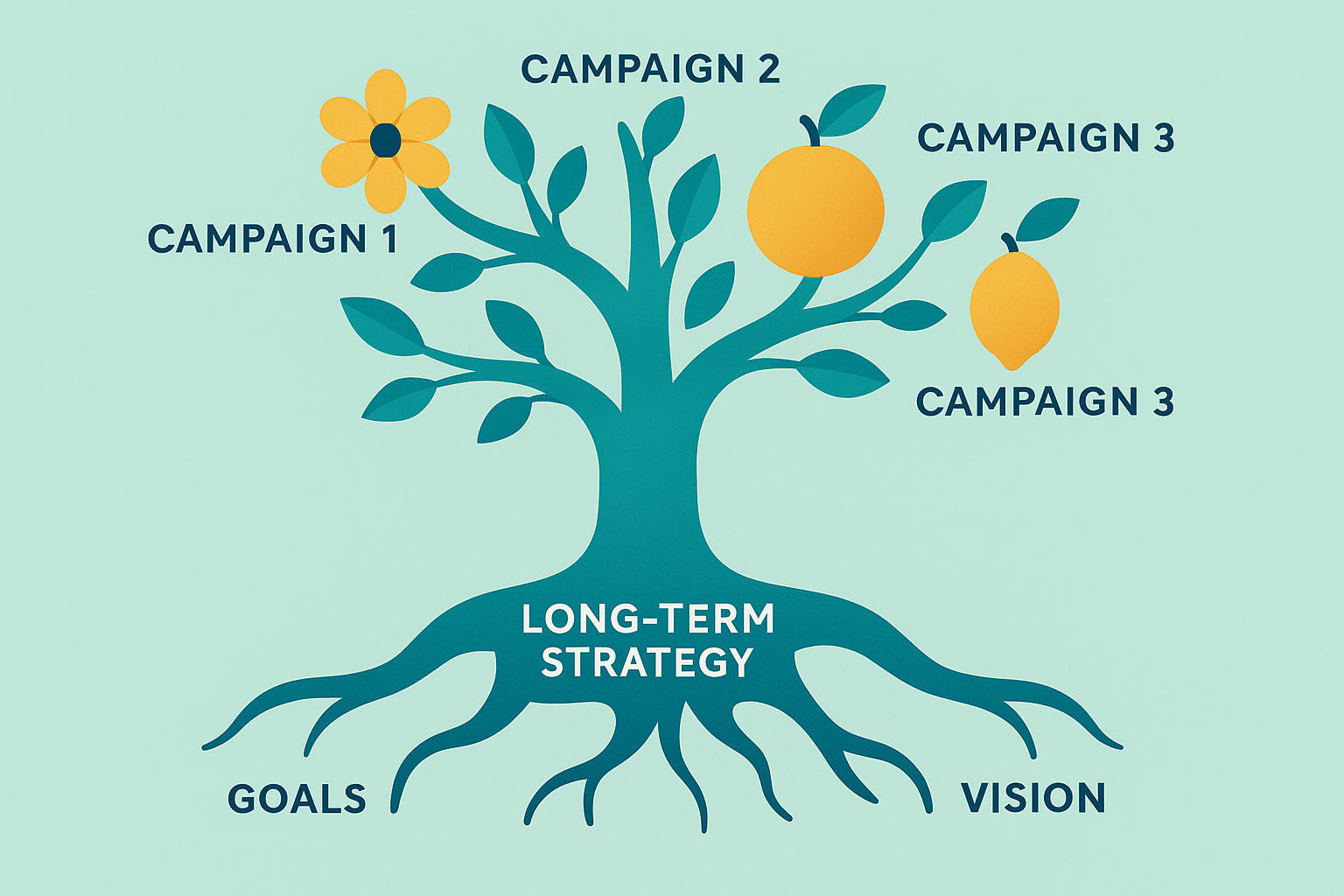Table of Contents

A Comprehensive Guide to Social Media Strategy
Building Campaigns That Actually Win
In today's digital landscape, having a social media presence isn't optional—it's essential. But posting random content and hoping for the best won't cut it anymore. You need a strategy built on understanding your audience and reaching them where they spend their time.
This guide will walk you through everything you need to create a social media strategy that doesn't just look good on paper but actually delivers results. Whether you're a small business owner, a marketing professional, or someone curious about how the best brands succeed online, you'll find actionable insights here.

Understanding the Difference Between Strategy and Campaign
Before we dive in, let's clear up a common confusion: your marketing strategy and your campaigns aren't the same thing.
Your Strategy
Your overarching plan—think of it as your North Star. It defines your goals for the next six to twelve months, identifies who you're trying to reach, and sets the frameworks that will guide all your marketing efforts.
Your Campaigns
The tactical execution within that strategy—focused bursts of effort designed to accomplish specific goals over one to three months. Every campaign should support your broader strategic objectives.

The Foundation: Defining Business Goals
Everything starts with knowing what you want to achieve. Vague aspirations like 'get more followers' won't cut it. You need SMARTSpecific, Measurable, Achievable, Relevant, and Time-bound goals—Specific, Measurable, Achievable, Relevant, and Time-bound.
What Effective Goals Look Like:
- ✓Increase brand awareness by 25% in six months (measured through reach and impressions)
- ✓Generate 50 qualified leads per month from social channels
- ✓Improve engagement rate to 4% across all platforms
- ✓Launch a new product line with 1,000 pre-orders in the first month
Pro Tip: Modern marketing platforms can help you set and track these goals systematically, ensuring your entire team stays aligned on what success looks like.

The Secret Weapon: Deep Audience Understanding
This is where most strategies fall apart—and where the magic happens if you get it right. You can't market effectively to 'everyone.' You need to understand your audience with surgical precision.
Beyond Basic Demographics
Sure, knowing your audience is '25-34, Female, Urban Professional' is a start. But that's just scratching the surface. The real power lies in understanding the layers beneath:
Psychographic Profiling
This is where you move from knowing who your audience is to understanding why they make decisions. Psychographics include:
- •Lifestyle Patterns: Are they early-bird gym-goers or midnight social scrollers?
- •Values and Beliefs: Do they prioritize sustainability? Are they driven by innovation or tradition?
- •Personality Traits: Risk-takers or cautious planners? Brand loyalists or deal seekers?
- •Interests and Hobbies: What do they do in their free time? What content do they consume?
The Power of Micro-Segmentation
This is where sophisticated marketing gets really exciting. Instead of treating your entire audience as one group, micro-segmentation breaks them into highly specific subgroups.
Think about it: Even within 'Urban Fitness-Conscious Millennials,' you have wildly different people. There's Sarah, the yoga enthusiast into sustainability. There's Marcus, training for marathons and obsessed with performance metrics. There's Jessica, a busy mom looking for quick 20-minute workouts she can do at home.
Advanced platforms can create and manage up to 25 distinct micro-segments automatically, each with its own content strategy—something that would be impossible to do manually at scale.

Competitive Intelligence That Actually Helps
Understanding your competitors isn't about copying what they do—it's about identifying opportunities they're missing and learning from what works for them.
What to Analyze
- ✓Platform Presence: Where are they active? Where are they conspicuously absent?
- ✓Content Strategy: What types of content get the most engagement?
- ✓Posting Frequency: How often do they post on each platform?
- ✓Engagement Metrics: Not just follower count, but how actively engaged their audience is
- ✓Brand Messaging: What promises are they making? What tone do they use?
Smart Tip: Analyzing 3-5 key competitors gives you enough data to spot patterns without getting overwhelmed. Look for gaps in their strategy that you can fill.

Choosing the Right Platforms
Not all social platforms are created equal, and you don't need to be everywhere. The key is being where your audience actually is.
Platform Personality Guide
B2B gold. Professional networking, thought leadership, industry insights. Perfect for reaching decision-makers.
Visual storytelling heaven. Lifestyle, fashion, food, travel brands. Strong with 18-45 demographics, especially for aspirational content.
TikTok
Entertainment-first, authenticity-driven. Younger audience, viral potential, creative freedom. Great for brands willing to have fun.
Community-building hub. Older demographics, local businesses, groups and communities. Still dominant for certain markets.
Twitter/X
Real-time conversations, news, customer service. Tech, media, and politically engaged audiences.
YouTube
Long-form education and entertainment. Tutorial-heavy, product reviews, entertainment. Second-largest search engine after Google.
The winning strategy? Start with 2-3 platforms where your target personas are most active, master those, then expand if needed.

Content Strategy: The Heartbeat of Your Social Accounts
Content is the currency of social media. Your strategy determines what you'll spend it on to attract attention and build relationships.
The Three Pillars of Outstanding Content
Educate
Teach your audience something valuable. How-tos, industry insights, debunking myths.
Entertain
Make them laugh, smile, or feel something. Memes, behind-the-scenes, storytelling.
Engage
Start a conversation. Ask questions, run polls, host Q&As.
Finding the Right Content Mix
- ✓Video: Dominates engagement. Short-form (Reels, TikToks) for reach, long-form (YouTube) for depth.
- ✓High-Quality Images: Infographics, carousels, user-generated content.
- ✓Text & Copy: Thought-provoking questions, insightful threads, compelling storytelling.
- ✓Interactive Content: Polls, quizzes, 'Ask Me Anything' sessions.
Pro Tip: Use a content calendar to plan your mix. ZorgSocial's Editorial Calendar is perfect for this, allowing you to visualize your strategy and ensure a balanced approach.

Metrics That Matter: Beyond Vanity Metrics
Data is your compass. But the wrong data leads you off a cliff. It's time to separate metrics that make you feel good from metrics that drive actual business results.
Vanity Metrics (The Feel-Good Traps)
- × Likes
- × Follower count (alone)
- × Impressions
Actionable Metrics (The Real Deal)
- ✓ Engagement Rate (Likes + Comments + Shares / Followers)
- ✓ Conversion Rate (clicks, signups, etc.)
- ✓ Cost Per Click (CPC) / Cost Per Acquisition (CPA)
- ✓ Share of Voice and Sentiment
ZorgSocial Advantage: Our analytics dashboard cuts through the noise, focusing on metrics directly tied to your ROI. We make it easy for you to see what's working and why.

Campaign Planning: From Idea to Execution
Campaigns are focused, time-bound initiatives designed to achieve a specific goal (like launching a product or promoting an event).
- 1.Define the Goal: What's the one most important outcome? (e.g., 500 webinar sign-ups).
- 2.Develop a Concept: The creative idea, messaging, and unique hashtag.
- 3.Create Assets: Design visuals, write copy, produce videos.
- 4.Schedule and Launch: Use a tool to schedule posts across platforms at optimal times.
- 5.Engage and Monitor: Respond to comments, track mentions, manage conversations.
- 6.Measure and Report: Did you hit your goal? What did you learn?
The ZorgSocial Difference: Our campaign management tools streamline this entire process, from asset management and scheduling to real-time analytics and reporting, all in one place.
Industry-Specific Considerations
Strategy isn't one-size-fits-all. Here's how to adapt:
B2B (Business-to-Business)
Focus on LinkedIn and Twitter. Content should be educational, professional, and value-driven (whitepapers, case studies, industry reports).
B2C (Business-to-Consumer)
Focus on Instagram, Facebook, TikTok, and Pinterest. Content should be visually engaging, relatable, and entertaining. User-generated content is king.
Non-Profit
Focus on Facebook and Instagram. Storytelling is critical. Drive donations, recruit volunteers, and raise awareness for your cause.
Regulated Industries (Healthcare, Finance)
Compliance is key. All content must be pre-approved. Focus on brand building, education, and customer service while avoiding specific claims.
Testing & Optimization: The Path to Mastery
Your first strategy is the starting point, not the finish line. Continuous improvement is the name of the game.
- ✓A/B Test Headlines: Does a question or a statement perform better?
- ✓Test Different Visuals: Does a lifestyle photo or an infographic get more shares?
- ✓Vary Your Call-to-Action: 'Learn More' vs. 'Shop Now' vs. 'Sign Up Free'.
- ✓Experiment with Posting Times: Use ZorgSocial's 'Best Time to Post' feature to analyze when your audience is most active, then test posting at different times.
The rule is simple: Analyze, hypothesize, test, and repeat.
Conclusion: Strategy Is a Living Thing
A social media strategy isn't a document you create once and file away. It's a living, breathing roadmap you review daily, adjust quarterly, and refine constantly. It's the system that turns random social media activity into a predictable engine for business growth.
Ready to Build a Winning Strategy?
Stop guessing and start growing. ZorgSocial provides the tools, analytics, and insights you need to turn your social media strategy into your biggest competitive advantage.

Ready to Put This Strategy Into Action?
Transform your social media presence with ZorgSocial's AI-powered platform that automates strategy execution while maintaining the human creativity that makes marketing resonate.